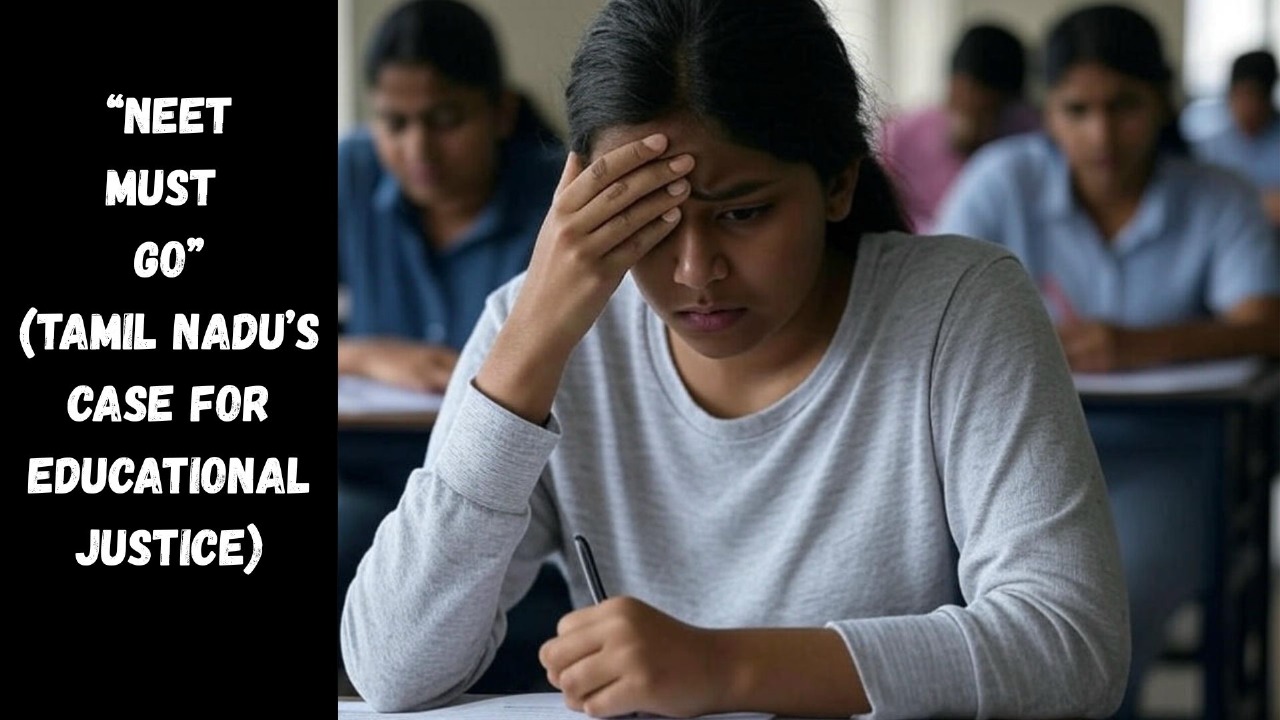INTRODUCTION
A significant development in the struggle for educational parity occurred when the President of India rejected Tamil Nadu’s bill to exempt the state from the National Eligibility cum Entrance Test (NEET). The Tamil Nadu Legislative Assembly unanimously approved the measure, which reflected the state’s stance that systemic inequities in medical education had been sustained by NEET in its current form.
This article will explore the history of this struggle and its impact. It will study the reason behind this fight for justice. It will also deliver some contemporary educational issues in our country. Our country need reforms because the current system is inadequate to ensure educational growth of the country.
REASON BEHIND THE STRUGGLE
NEET’s main flaw is that it follows the Central Board of Secondary Education (CBSE) curriculum, which severely disadvantages Tamil Nadu State Board (TNSBSE) pupils. Prior to the implementation of NEET, the State Board accounted for over 70% of medical students in Tamil Nadu. That percentage has since fallen to less than 47%, while students from CBSE schools now make up 27% of medical seats—a sharp increase from less than 1% prior to the NEET period. This disparity results from a mismatch between the two curricula rather than a lack of quality in State Board schooling. Students on the State Board are essentially starting the race with a disadvantage since they are expected to compete on criteria created for a different system.
The expensive coaching culture, where candidates frequently spend between ₹1 and ₹5 lakh a year for preparation, has also been institutionalized by NEET. Due to their inability to pay for coaching sessions, students from low-income, rural, and first-generation learning backgrounds have been further disadvantaged. The percentage of scientific students in Tamil Nadu government schools fell from 43% to 35% in 2020–21, indicating that these pupils had given up. The state implemented a 7.5% horizontal reserve for government school students in medical admissions in order to remedy this. In 2024, all 622 of the seats available under this quota were filled, demonstrating that the problem is not a lack of talent but rather a lack of opportunity.
IMPORTANCE AND IMPACT OF MEDICAL EDUCATION
Academic achievement is only one aspect of medical education. The traits that standardized examinations like NEET cannot evaluate include empathy, public service, and a sustained commitment to society. The previous system in Tamil Nadu, which was based on Class 12 grades, generated a large number of first-generation physicians who later strengthened the public health infrastructure by working in rural regions. However, NEET poses a threat to replace this pipeline with professionals who are more focused on cities and might not be as dedicated to public service.
ERASURE OF STATE AUTONOMY
Despite strong state support, Tamil Nadu’s NEET exemption bills were rejected, which highlights the decline in governmental authority over education. The Constitution’s Concurrent List includes education, but states must be permitted to take into consideration their own particular social and educational circumstances. A one-size-fits-all central template cannot replace Tamil Nadu’s social justice-focused model without compromising the cooperative federalism spirit.
NEET proponents frequently claim that it guarantees the calibre of medical personnel. But this assertion is false. Regardless of the method of admission, all students are subject to the same academic requirements, tests, and clinical training after they are accepted. Therefore, the emphasis should be on how the educational system assists students during their training rather than how they are chosen.
WAY FORWARD
Certain suggestions are as follows –
FROM CONCURRENT LIST TO STATE LIST
By moving education from the Concurrent List to the State List of the Constitution, states would have greater freedom and flexibility to choose their own admittance requirements and policies. In addition to preventing disputes with the Centre over common entry exams like NEET, this will allow the states to create their educational systems in accordance with their local needs and goals.
QUALITY AND EQUALITY
Creating a more comprehensive and inclusive admissions procedure that takes into account not only Class XII and NEET scores but also other elements including ability, socioeconomic position, regional diversity, and rural service could be one way to address this issue. This will guarantee that social fairness and merit are upheld and that students from various origins have an equal chance to fulfill their aspirations of becoming doctors.
CONCLUSION
NEET in its current form does not promote educational achievement or justice. In addition to failing to fully use India’s vast talent pool, it has widened conflicts. The goal of Tamil Nadu’s opposition to NEET is to challenge an inefficient system that links financial resources and merit, not to decrease academic standards. The Centre needs to reconsider the medical admissions procedure and pay attention to the opinions of students, teachers, and civil society in order to genuinely empower India’s youth. Education ought to support equity rather than stand in the way of aspirations.
About Author

SAHIL YADAV, a law student at NLIU Bhopal, is a dedicated and passionate legal writer, who is keen to explore International law, Constitutional Law, Criminal Law, Forensic Psychology and publish research papers and articles on contemporary legal nuances and issues. He is also interested in intersection of disciplines like history, psychology, political science, philosophy, and sociology with law.

